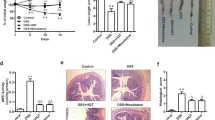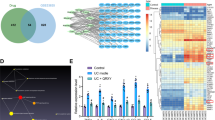Abstract
Objective
To investigate the protective effect of Chinese herbal formula Huangqin Decoction (HQD) on ulcerative colitis mouse model induced by dextran sulphate sodium (DSS) and human intestinal epithelial cell injury induced by tumour necrosis factor-α (TNF-α).
Methods
In vivo, 30 male C57BL/6 mice were divided into 5 groups using a random number table (n=6 per group), including control, DSS, 5-aminosalicylic acid (5-ASA), HQD low- (HQD-L) and high-dose (HQD-H) groups. The colitis mouse model was established by 3% (w/v) DSS water for 5 days. Meanwhile, mice in the HQD-L, HQD-H and 5-ASA groups were administrated with 100, 200 mg/kg HQD or 100 mg/kg 5-ASA, respectively, once daily by gavage. After 9 days of administration, the body weight, disease activity index (DAI) score and colon length of mice were measured, the pathological changes of colons were analyzed by hematoxylin-eosin staining (HE) staining, and the levels of serum interleukin (IL)-6, IL-1β and TNF-α were measured by enzyme linked immunosorbent assay. In vitro, the human colon epithelial normal cells (FHC cells) were exposed to HQD (0.6 mg/mL) for 12 h and then treated with TNF-α (10 ng/mL) for 24 h. The tight junction (TJ) protein expression levels of Claudin-4 and Occludin, and the protein phosphorylation levels of p65 and inhibitor of nuclear factor kappaB (NF-κB)-α (IκBα) were measured by Western blot.
Results
In vivo, compared with the DSS group, HQD-H treatment attenuated the weight loss and reduced DAI score of mice on the 8th day (P<0.05). Moreover, HQD-H treatment ameliorated the colon shortening in the DSS-induced colitis mice (P<0.05). HE staining showed HQD attenuated the pathological changes of colitis mice, and the histological scores of HQD-H and 5-ASA groups were significantly decreased compared with the DSS group (P<0.05). Meanwhile, HQD-H and 5-ASA significantly decreased the serum IL-1β, IL-6 and TNF-α levels of mice (P<0.05). In vitro experiments showed that HQD up-regulated Occludin and Claudin-4 protein expressions and inhibited p-p65 and p-IκBα levels in FHC cells compared with the TNF-α group (P<0.05).
Conclusion
HQD significantly relieved the symptoms in DSS-induced colitis mice by inhibiting pro-inflammatory cytokines expression and maintained the homeostasis of TJ protein in FHC cells by suppressing TNF-α-induced NF-κB activation.
Similar content being viewed by others
References
Alipour M, Zaidi D, Valcheva R, Jovel J, Martinez I, Sergi C, et al. Mucosal barrier depletion and loss of bacterial diversity are primary abnormalities in paediatric ulcerative colitis. J Crohns Colitis 2016;10:462–471.
Awad WA, Hess C, Hess M. Enteric pathogens and their toxin-induced disruption of the intestinal barrier through alteration of tight junctions in chickens. Toxins (Basel) 2017;9:60.
Sawada N. Tight junction-related human diseases. Pathol Int 2013;63:1–12.
van Itallie CM, Anderson JM. Architecture of tight junctions and principles of molecular composition. Semin Cell Dev Biol 2014;36:157–165.
Oshima T, Miwa H, Joh T. Changes in the expression of claudins in active ulcerative colitis. J Gastroenterol Hepatol 2008;23(Suppl 2):S146–S150.
Al-Sadi RM, Ma TY. IL-1beta causes an increase in intestinal epithelial tight junction permeability. J Immunol 2007;178:4641–4649.
Capaldo CT, Nusrat A. Cytokine regulation of tight junctions. Biochim Biophys Acta 2009;1788:864–871.
Lee B, Moon KM, Kim CY. Tight junction in the intestinal epithelium: its association with diseases and regulation by phytochemicals. J Immunol Res 2018;2018:2645465.
Lam W, Jiang Z, Guan F, Huang X, Hu R, Wang J, et al. PHY906 (KD018), an adjuvant based on a 1800-year-old Chinese medicine, enhanced the anti-tumor activity of Sorafenib by changing the tumor microenvironment. Sci Rep 2015;5:9384.
Wang C, Tang X, Zhang L. Huangqin-Tang and ingredients in modulating the pathogenesis of ulcerative colitis. Evid Based Complement Alternat Med 2017;2017:7016468.
Zuo F, Zhou ZM, Zhang Q, Mao D, Xiong YL, Wang YL, et al. Pharmacokinetic study on the multi-constituents of Huangqin-Tang decoction in rats. Biol Pharm Bull 2003;26:911–919.
Wirtz S, Popp V, Kindermann M, Gerlach K, Weigmann B, Fichtner-Feigl S, et al. Chemically induced mouse models of acute and chronic intestinal inflammation. Nat Protoc 2017;12:1295–1309.
Yang R, Liao Y, Wang L, He P, Hu Y, Yuan D, et al. Exosomes derived from M2b macrophages attenuate DSS-induced colitis. Front Immunol 2019;10:2346.
Dai YC, Zhang YL, Wang LJ, Guo Q, Yang K, Ye RH, et al. Clinical presentation and treatment strategies for ulcerative colitis: a retrospective study of 247 inpatients. Chin J Integr Med 2016;22:811–816.
Eichele DD, Kharbanda KK. Dextran sodium sulfate colitis murine model: an indispensable tool for advancing our understanding of inflammatory bowel diseases pathogenesis. World J Gastroenterol 2017;23:6016–6029.
Heinemann U, Schuetz A. Structural features of tight-junction proteins. Int J Mol Sci 2019;20:6020.
Forster C. Tight junctions and the modulation of barrier function in disease. Histochem Cell Biol 2008;130:55–70.
Capaldo CT, Farkas AE, Hilgarth RS, Krug SM, Wolf MF, Benedik JK, et al. Proinflammatory cytokine-induced tight junction remodeling through dynamic self-assembly of claudins. Mol Biol Cell 2014;25:2710–2719.
Merga YJ, O’Hara A, Burkitt MD, Duckworth CA, Probert CS, Campbell BJ, et al. Importance of the alternative NF-kappaB activation pathway in inflammation-associated gastrointestinal carcinogenesis. Am J Physiol Gastrointest Liver Physiol 2016;310:G1081–G1090.
Kato A. Group 2 innate lymphoid cells in airway diseases. Chest 2019;156:141–149.
Author information
Authors and Affiliations
Contributions
Gu LM, Li H, and Pan CY conceived and carried out the experiments. Xia JQ and Gu C conceived the experiments and analyzed data. Tian YZ designed the experiment. Gu LM and Tian YZ wrote the manuscript. All authors read and approved the final version.
Corresponding author
Additional information
Conflict of Interest
The authors declare no conflict of interest.
Supported by the Scientific Research Project of Jiangsu Provincial Administration of Traditional Chinese Medicine (No. JD2019SZXYB05), Natural Science Foundation of Nanjing University of Chinese Medicine (No. XZR2020030), and National Administration of Traditional Chinese Medicine: 2019 Project of Building Evidence-Based Practice Capacity for Traditional Chinese Medicine (No. 2019XZZX-XH007)
Electronic Supplementary Material
Rights and permissions
About this article
Cite this article
Gu, Lm., Li, H., Xia, Jq. et al. Huangqin Decoction Attenuates DSS-Induced Mucosal Damage and Promotes Epithelial Repair via Inhibiting TNF-α-Induced NF-κB Activation. Chin. J. Integr. Med. 28, 124–129 (2022). https://doi.org/10.1007/s11655-021-3343-4
Accepted:
Published:
Issue Date:
DOI: https://doi.org/10.1007/s11655-021-3343-4




